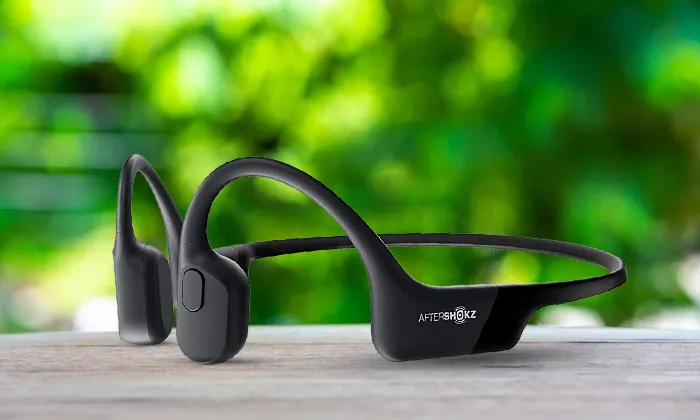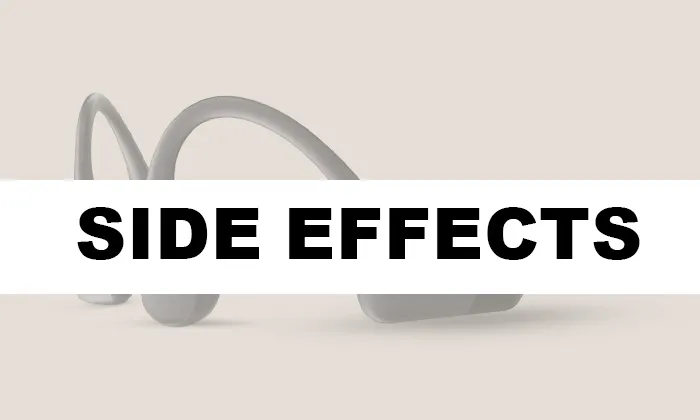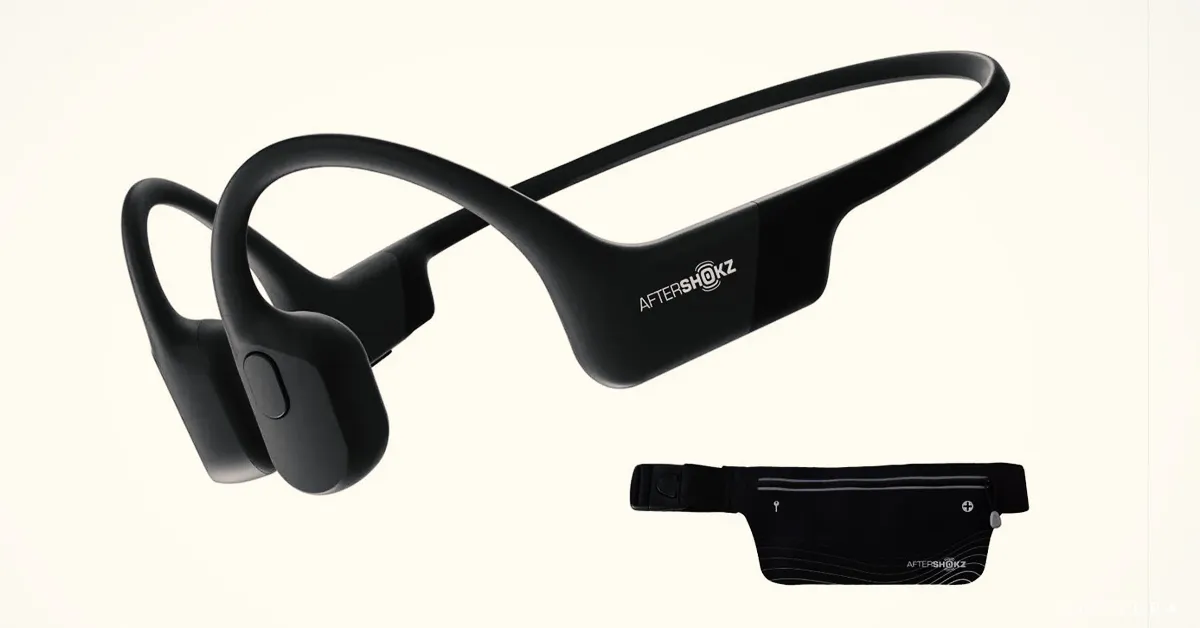Have you ever found yourself drifting off to sleep while listening to your favorite tunes or soothing sounds? If you’re a music lover or enjoy some background noise while dozing off, you might be wondering if it’s possible to wear bone-conduction headphones during your slumber.
Well, the answer is a resounding “Yes, you can!” Unlike traditional headphones, bone conduction headphones exert no pressure on the outer ear and leave the ear canal unobstructed.
As someone who has experienced the quest for the perfect sleeping headphones, I understand the importance of finding comfortable and safe options that won’t interfere with your restful night’s sleep.
In this article, we’ll explore both the positive and potential drawbacks of using bone-conduction headphones while sleeping, allowing you to make an informed decision about incorporating them into your bedtime routine.
How Do Bone Conduction Headphones Work?
Before we dive into whether or not it’s safe to wear bone-conduction headphones while sleeping, let’s first understand what these headphones are and how they work.
Bone conduction headphones are a type of headphones that work by transmitting sound waves through your cheekbones and directly into your inner ear.
Unlike traditional headphones, which sit over or inside your ears, bone conduction headphones don’t block your ear canal, allowing you to hear sounds from your environment as well as the audio you’re playing.
This unique technology makes bone-conduction headphones an excellent choice for outdoor activities, where it’s important to stay aware of your surroundings. But what about using them while sleeping? Let’s find out.
How long can you wear Bone-Conduction Headphones?
Bone-conduction headphones are a type of headphones that use vibrations to transmit sound through your cheekbones and jawbones, bypassing your eardrums.
They are designed to let you hear your surroundings while listening to music or other audio. However, they may not be suitable for everyone or for long periods of time.
According to some sources, bone-conduction headphones can cause pressure and skin irritation in the areas where they rest, especially if they are worn for too long or too tight.
They can also produce a tingling sensation on your cheekbones if the volume is too high or the vibration is too strong. Some people may find these effects uncomfortable or annoying.
Additionally, bone-conduction headphones may not be able to prevent hearing loss or noise-induced hearing damage if you expose yourself to loud sounds for a long time.
Even though they do not block your ears, they still deliver sound to your inner ear through your bones. Therefore, you should still be careful about the volume level and duration of your listening.
There is no definitive answer to how long you can wear bone-conduction headphones safely, as it may depend on your personal preference, comfort level, and hearing condition. However, some general tips are:
- Choose a pair of bone-conduction headphones that fit well and have adjustable frames
- Avoid wearing them for more than a few hours at a time
- Take breaks and remove them periodically to relieve pressure and irritation
- Keep the volume at a moderate level and avoid loud noises
- Consult your doctor if you have any existing hearing problems or concerns.

Do Bone-Conduction headphones block external noise?
The Straight forward answer is “NO”, the bone-conduction headphones do not block external noise. They leave your ears open and allow you to hear ambient sounds while listening to audio.
This can be useful for situations where you need to be aware of your surroundings, such as running, cycling, driving, or working in a noisy environment.
However, if you’re looking for a way to isolate yourself from unwanted noise or enjoy a more immersive sound quality, bone-conduction headphones may not be the best choice.
In such cases, traditional noise-canceling headphones may be a better fit for your needs.
Bone Conduction Headphones for Sleeping Pros & Cons
| Pros | Cons |
|---|---|
| Comfortable and suitable for sleeping | Sound leakage |
| Open-ear design for ambient awareness | Reduced sound quality |
| Can improve sleep quality | Discomfort or pressure on head or temples |
| Convenient for incorporating white noise | Limited noise isolation |
| Affordable options available | Personal sensitivity to vibrations |
| Does not obstruct ear canals | Headaches after sleeping |
| Promotes ear health and safety | Interference with circadian rhythm |
| Excessive sound volume | |
| Incompatible design for sleep | |
| More external noise |
How Bone Conduction Headphones Impact Sleep Quality?
The impact of bone-conduction headphones on sleep quality is a topic of interest for many. While these innovative headphones offer the convenience of listening to audio while sleeping, their usage can have various effects on sleep quality.
- Comfort
- Quality of sound
- Vibration for relaxation
- Sleep Quality
- Health and Safety Benefits
- White Noise
- Affordability
- Prevent obstruction of your ear canals
Comfort
When it comes to wearing bone-conduction headphones during sleep, comfort plays a significant role in the overall sleep experience.
The good news is that studies have shown promising results regarding the comfort and sleep quality benefits of these headphones.
Research has demonstrated that wearing bone-conduction headphones during sleep can enhance sleep quality by increasing the duration of slow-wave sleep cycles, also known as deep sleep.
Deep sleep is crucial for physical rest and mental restoration, as it helps the body recover and rejuvenate. By providing a comfortable fit and allowing for the natural flow of sound, bone-conduction headphones contribute to a more relaxed and soothing sleep environment.
Sound Quality
Bone conduction headphones deliver clear and intelligible sound, but may lack the depth and richness of other headphone types due to their focus on sound transmission rather than high-fidelity audio.
Advances in bone conduction technology have led to improvements in sound quality, but personal preferences and hearing abilities can also influence perception.
Vibration for relaxation
Bone conduction headphones provide the added benefit of gentle vibrations that can contribute to relaxation. The vibrations produced by these headphones can create a soothing sensation, promoting a sense of calmness and aiding in relaxation.
This feature can be particularly beneficial for individuals seeking to unwind or achieve a more relaxed state before sleep.
Sleep Quality
Sleep quality is a crucial aspect to consider when using bone-conduction headphones during sleep. One factor that contributes to their impact on sleep quality is the sound frequency they produce.
Compared to traditional headphones, bone conduction headphones typically operate at lower sound frequencies. This lower frequency range is known to have a calming and soothing effect on the body, which can aid in promoting more restful sleep.
Research shows that lower frequencies are more calming than higher frequencies
The gentle vibrations and lower frequencies emitted by bone-conduction headphones can help create a serene and relaxing environment conducive to a better sleep experience.
Prevent obstruction of your ear canals
One notable advantage of bone conduction headphones is that they prevent obstruction of the ear canals. Unlike traditional headphones that fit inside or over the ears, bone conduction headphones rest outside the ears, leaving the ear canals open and unobstructed.
This design feature offers several benefits.
Firstly, it allows for natural airflow, reducing the likelihood of discomfort or irritation that can occur with prolonged use of in-ear or over-ear headphones.
Secondly, it helps to prevent the accumulation of moisture or heat in the ear canals, which can be a concern for some individuals.
Lastly, by keeping the ear canals unobstructed, bone-conduction headphones minimize the risk of potential issues such as ear infections or pressure-related discomfort.
Health and Safety Benefits
Using bone-conduction headphones during sleep offers several health and safety benefits. Firstly, these headphones do not block the ear canals, allowing for unobstructed airflow. This can help prevent discomfort, irritation, or potential issues associated with prolonged use of in-ear or over-ear headphones.
The lightweight and comfortable design of bone-conduction headphones reduces the risk of pressure points or discomfort that can occur with other headphone types, contributing to a more pleasant sleep experience.
White Noise
White noise refers to a consistent and soothing sound that covers up other sounds in the environment. It creates a gentle background noise that can help mask external disturbances, promoting more peaceful and uninterrupted sleep. Bone conduction headphones allow you to listen to white noise directly without the need for additional speakers or devices.
Affordability
Affordability is another advantage of bone-conduction headphones. They are available at various price points, making them a more budget-friendly option compared to some high-end traditional headphones.
Click Here to See the Latest Prices of Bone-Conduction Headphones.

Side Effects of Bone Conduction Headphones
While bone conduction headphones offer unique benefits, it’s important to be aware of potential side effects that may affect some individuals. Here are a few considerations:
Incompatible design for sleep
While bone conduction headphones are designed to be comfortable, their specific design may not be ideal for everyone’s sleep positions or preferences.
The headband or frame of the headphones may interfere with certain sleeping positions, causing discomfort or an awkward fit.
Hearing loss
Bone conduction headphones pass sound waves directly to the cochlea in the inner ear. If the volume is too loud or the exposure is too long, it can damage the cochlea and cause hearing loss. This is similar to any other type of headphones that deliver sound to the inner ear.
Limited Noise Isolation
Since bone conduction headphones do not block the ear canals, they may not provide effective noise isolation.
This means that external noises may still be audible while using these headphones, which can be a disadvantage if you’re seeking complete noise cancellation.
Tinnitus
Bone conduction headphones skip the eardrums while sending sound waves. This can cause a ringing or buzzing sound in the ears, known as tinnitus.
Tinnitus can be temporary or permanent and can affect your sleep quality and concentration.
Headache and vertigo
Bone conduction headphones create vibrations on your cheekbones and temples. These vibrations can cause discomfort and strain on your inner ear and head.
This can lead to headaches and vertigo, which is a sensation of spinning or dizziness. Vertigo can also affect your balance and coordination.
Skin irritation
Bone conduction headphones rest on your skin above your ears and can cause pressure. Some people experience skin irritation, often when they are worn for long periods of time.
It is to be expected that any product used or worn for an extended length of time could cause discomfort.
These side effects may not affect everyone and may depend on your personal preference, comfort level, and hearing condition.
Tips for Improving Sleep with Bone Conduction Headphones
When using bone-conduction headphones during sleep, there are several tips you can follow to optimize your sleep experience.
Adjust the volume
Set the volume of the bone conduction headphones to a comfortable level that allows you to hear the audio clearly without being too loud.
Avoid excessive volume levels that may disturb your sleep or lead to hearing damage.
Choose soothing sounds
Opt for calming and relaxing sounds, such as nature sounds, white noise, or soft instrumental music. These gentle sounds can help create a peaceful sleep environment and promote relaxation.
Use a sleep timer
If you like to fall asleep while listening to the audio, consider using a sleep timer feature on your device or audio player.
This allows the audio to automatically turn off after a set period, ensuring you’re not disturbed by sound throughout the entire night.
Position the headphones comfortably
Ensure that the bone conduction headphones are properly positioned and comfortably fitted on your head.
Adjust the headband or frame to avoid any pressure points or discomfort that could affect your sleep quality.
Establish a bedtime routine
Create a consistent bedtime routine that includes using bone-conduction headphones as part of your relaxation ritual.
By incorporating the headphones into your routine, you signal to your body that it’s time to wind down and prepare for sleep.
Experiment with different sleep positions
Test out different sleeping positions to find the one that offers the best comfort and minimal interference with the headphones.
This may involve adjusting the positioning of the headband or finding a pillow that accommodates the headphones comfortably.
Consider sleep mask compatibility
If you prefer to use a sleep mask for complete darkness, ensure that it doesn’t interfere with the placement or comfort of the bone-conduction headphones.
Look for a sleep mask that allows space for the headphones or consider using a mask specifically designed for use with headphones.
Limit screen time before bed
Engaging in excessive screen time before sleep can negatively impact your sleep quality. Avoid using electronic devices or exposing yourself to bright screens close to bedtime, as the blue light emitted by screens can disrupt your natural sleep-wake cycle.
Bone Conduction Headphones VS Traditional Headphones
Bone conduction headphones and traditional headphones are two distinct types of audio devices, each with its own set of advantages and limitations. Here’s a comparison between the two:
| Comparison Factors | Bone Conduction Headphones | Traditional Headphones |
|---|---|---|
| Sound Transmission | Through bone conduction | Directly to the eardrums |
| Ambient Awareness | Allows for open-ear listening | Can block external noise |
| Comfort and Fit | Lightweight and ergonomic design | Varied options; depends on personal preference |
| Sound Quality | May have limitations in depth and richness | Offers high-fidelity sound and immersive experience |
| Noise Isolation | Provides less noise isolation | Can provide better noise isolation |
| Application and Use Cases | Ideal for outdoor activities, sports, situational awareness | Wide range of applications, including music, gaming, and audio editing |
| Purpose | Suitable for those with hearing conditions or discomfort with in-ear or over-ear headphones | Versatile use for various listening purposes |
Sound Transmission
Traditional headphones use speakers that sit over or inside the ears, delivering sound directly to the eardrums. In contrast, bone conduction headphones bypass the eardrums and transmit sound vibrations through the bones of the skull to the inner ear.
This unique transmission method allows for open-ear listening, keeping the ear canals unobstructed.
Ambient Awareness
Bone conduction headphones excel in maintaining situational awareness. By leaving the ears open, they allow you to hear external sounds, such as traffic, conversations, or alarms.
This can be beneficial for activities like running, cycling, or working in environments where it’s important to stay aware of your surroundings.
Traditional headphones, especially over-ear or noise-canceling models, tend to block out external noise, potentially limiting awareness.
Comfort and Fit
Traditional headphones come in various designs, including over-ear, on-ear, and in-ear styles. Finding the right fit and comfort level can depend on individual preferences and ear anatomy.
Bone conduction headphones typically have a lightweight and ergonomic design that sits on the temporal bones, providing a comfortable and secure fit for many users.
Sound Quality
Traditional headphones are known for their ability to deliver high-fidelity sound with a wide frequency response range. They often provide a more immersive audio experience, with better bass response and overall sound clarity.
Bone conduction headphones, while improving in sound quality over time, may not offer the same level of depth and richness due to the nature of sound transmission through the bones.
Noise Isolation
Traditional headphones, particularly over-ear or in-ear models, provide better noise isolation by physically blocking external sounds. This can create a more immersive listening experience, reducing distractions from the environment.
Bone conduction headphones, on the other hand, allow for natural ambient sound awareness, making them less effective in noise isolation.
Application and Use Cases
Traditional headphones are widely used for various purposes, including music listening, gaming, audio editing, and private listening.
Bone-conduction headphones are often preferred for outdoor activities, sports, and situations where situational awareness is crucial.
They can also be beneficial for individuals with certain hearing conditions or those who experience discomfort with in-ear or over-ear headphones.
Final Thoughts
Bone conduction headphones offer a unique and versatile option for those looking to listen to the audio while sleeping. With their open-ear design and comfortable fit, they provide a convenient solution for individuals who want to enjoy music, white noise, or other audio content without blocking the ear canals.
While they may have some limitations, such as reduced sound quality and potential sound leakage, bone conduction headphones excel in promoting situational awareness and maintaining ear health.
As with any audio device, it’s important to find the right fit and volume levels that suit your preferences and prioritize your overall sleep quality.
- Charging Bluetooth Headphones During Use: Is It Possible? - January 9, 2024
- Why Over-Ear Headphones Best for Hearing Health? (7 Reasons) - December 12, 2023
- Fixing the Bose Earbuds Not Charging in Case Problem: Solutions That Work - November 24, 2023
